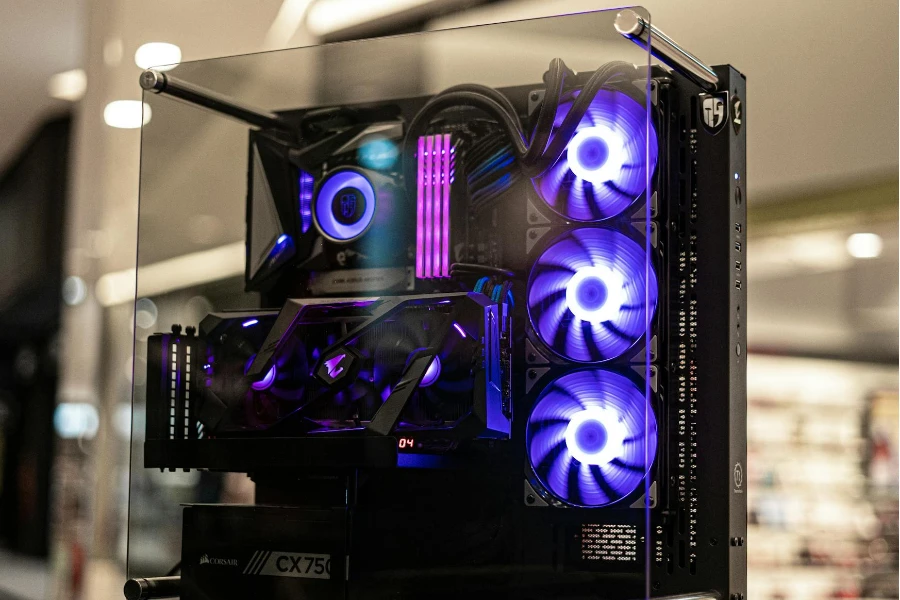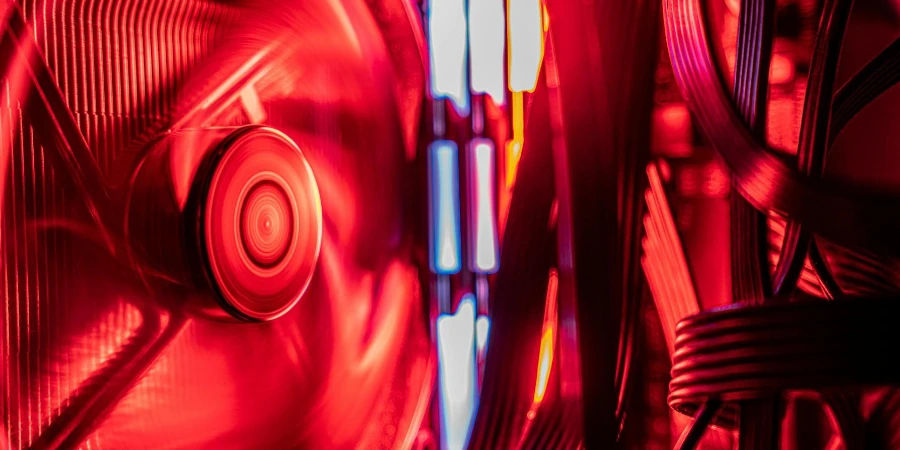Table of Contents
● Introduction
● Market overview
● Key technology and design innovations
● Current trends in gaming computer case designs
● Conclusion
Introduction
Gaming computer cases have transcended their traditional roles, evolving from mere protective housings to pivotal components that enhance both performance and aesthetics within the gaming community. These cases are no longer just about safeguarding hardware; they are integral to optimizing airflow, supporting advanced cooling systems, and enabling high-end performance. Moreover, with the incorporation of features like RGB lighting and tempered glass panels, they offer a canvas for personal expression and style, making every setup a reflection of the individual’s personality and gaming ethos. As such, they hold a dual appeal, attracting both hardcore gamers who prioritize function and enthusiasts who value form. This dual focus is reshaping how manufacturers approach the design and functionality of computer cases, pushing the boundaries of innovation in the gaming industry.
Market overview

The global market for gaming computer cases has been witnessing a notable expansion, driven by the surge in gaming popularity and the increasing demand for high-performance computing setups. According to Advance Market Analytics, the market is expected to grow at a compound annual growth rate (CAGR) of 5.8% through to 2030. This growth is fueled by both technological advancements and a heightened interest in gaming across various demographics. The market landscape is dominated by key players from Asia, particularly Taiwanese manufacturers like Thermaltake, NZXT Inc., and Lian Li, who are renowned for their innovative designs and robust manufacturing capabilities.
Market share
The regional dynamics in the gaming computer case market highlight significant demand in both the Asia-Pacific and North American regions. According to Statista, Asia-Pacific leads in global gaming revenue, generating nearly half of the worldwide total, while North America closely follows. These regions are driven by a large base of gaming enthusiasts and tech-savvy consumers. Their gaming centers require advanced PC cases with superior cooling and greater customization. The European market, accounting for around 20% of global gaming revenue, is slightly more mature but continues to evolve with a preference for visually appealing yet functional designs that align with the global shift towards gaming setups that combine aesthetics and technical proficiency.
Growth patterns
Market trends show a shift towards more environmentally sustainable materials and energy-efficient designs, influenced by the broader consumer electronics industry’s focus on sustainability. According to GlobalData, the gaming market is expected to reach a value of $276 billion by 2033, growing at a CAGR of over 10%. This growth is leading to a stronger emphasis on eco-friendly designs as companies increasingly cater to eco-conscious gamers by incorporating recyclable materials and optimizing power efficiency while maintaining high-performance standards.
Key technology and design innovations

Delving deeper into the technical advancements, gaming computer cases have incorporated specific high-performance features that significantly elevate user experience and system efficiency. Advanced cooling technologies now include dedicated channels for optimized airflow, strategic placement of fan mounts to support up to 360 mm radiators, and integrated liquid cooling systems that ensure sustained thermal management even under extreme loads. For example, the latest designs from companies like Corsair and NZXT feature dynamic fan speed adjustments that respond to system temperature changes in real time, ensuring optimal cooling without excessive noise.
On the modularity front, recent case designs offer tool-less access and adjustable brackets that support a wide range of motherboard sizes from mini-ITX to extended ATX. This flexibility allows gamers to build highly customized setups with ease. Additionally, some cases now include modular drive bays that can be repositioned or removed altogether to accommodate larger graphics cards or additional cooling systems, providing a tailored fit for any configuration.
In terms of aesthetics and functionality, RGB lighting systems have evolved to include software-controlled settings with millions of color combinations and patterns that can be synchronized across multiple devices. This integration extends to tempered glass panels which are now engineered with durability in mind, featuring scratch-resistant surfaces and anti-vibration mounts to minimize noise. These panels often incorporate noise-dampening materials to further enhance acoustic performance, a crucial consideration for streamers and competitive gamers.
Furthermore, the introduction of smart features such as built-in digital controllers for RGB lighting and fan speeds allows users to fine-tune their setups via desktop or mobile apps. These controllers can also monitor system performance metrics like temperature and load, adjusting operational settings automatically to maintain efficiency and longevity of the components.
These technical enhancements are a testament to the industry’s commitment to pushing the boundaries of what gaming computer cases can offer, merging cutting-edge technology with user-centric design to cater to the diverse and ever-evolving needs of the gaming community.
Current trends in gaming computer case designs
The current market trends in the gaming computer case sector highlight a distinct shift towards minimalist designs that blend sleek aesthetics with robust functionality. The trend towards minimalism is not merely a stylistic choice but a response to consumer demands for setups that are both space-efficient and powerful. These minimalist cases often feature clean lines and unobtrusive designs that make them suitable for both gaming setups and professional environments. According to Volta PC, the focus on minimalist cases aligns with the broader trend of compact living spaces and the need for more versatile computing solutions that cater to both work and play.
Thermal efficiency
Thermal efficiency remains a critical focus in gaming computer case design as GPUs, CPUs, and other components grow more powerful and generate greater heat. Innovations such as strategically integrated ventilation systems are designed to guide airflow through optimized channels that direct cool air to high-priority components like the CPU and GPU, and then push hot air out through exhaust fans or radiator mounts. Increased fan mounts now accommodate up to seven 120 mm or 140 mm fans, while specialized mesh front panels, with over 50% open area, provide unrestricted air intake. Optimized cases also feature multiple radiator support, accommodating up to 420 mm radiators for custom water-cooling loops or all-in-one liquid cooling systems. Modular designs with removable drive cages, adjustable fan mounts, and specialized dust filters prevent obstruction of airflow, helping to maintain peak performance. This engineering not only ensures efficient cooling but also minimizes dust accumulation, reducing the chances of overheating while extending the lifespan of components.
Visual appeal

The consumer demand for high-performance yet visually appealing cases has significantly influenced market direction. Gamers and enthusiasts are no longer content with just functional hardware; they seek cases that make a visual statement. This demand has spurred manufacturers to invest in R&D that marries form with function, leading to the development of cases that feature both custom RGB lighting and enhanced airflow designs. As highlighted by Antec, this blend of aesthetics and performance is now a key selling point that differentiates products in a competitive market.
Flexibility
Manufacturers are also focusing on creating cases that can support a wide range of components from different manufacturers, ensuring that users have the flexibility to build highly customized and personal rigs. The trend towards modularity in case design allows for various setups, from high-powered gaming stations to quiet, efficient workstations, catering to a broader range of consumer needs.
These trends underscore a dynamic shift in the gaming computer case market, where consumer preferences for style, performance, and adaptability drive innovation, pushing manufacturers to continually evolve and redefine what a gaming case can offer.
Conclusion
The evolution of gaming computer cases reflects a market increasingly driven by the dual demands for good performance and aesthetic appeal. As we have seen, advancements in cooling technology, modularity, and smart features are shaping current designs, with manufacturers responding to the call for minimalist yet functional cases that align with modern lifestyle needs. Looking ahead, we can anticipate further innovations in thermal management and customization options as technology progresses, meeting the growing expectations of a diverse gaming community. These future developments are likely to continue pushing the boundaries of design and functionality, ensuring that gaming computer cases not only keep pace with hardware advancements but also resonate with users’ evolving preferences and styles.




